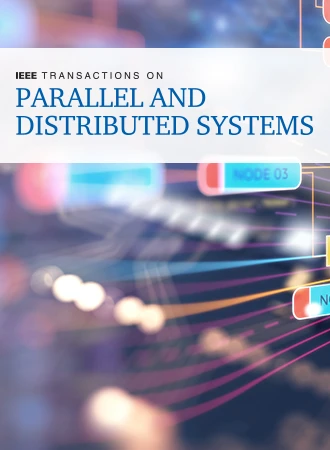PWDFT-SW: Extending the Limit of Plane-Wave DFT Calculations to 16K Atoms on the New Sunway Supercomputer
IF 5.6
2区 计算机科学
Q1 COMPUTER SCIENCE, THEORY & METHODS
IEEE Transactions on Parallel and Distributed Systems
Pub Date : 2025-04-07
DOI:10.1109/TPDS.2025.3557621
引用次数: 0
Abstract
First-principles density functional theory (DFT) with plane wave (PW) basis set is the most widely used method in quantum mechanical material simulations due to its advantages in accuracy and universality. However, a perceived drawback of PW-based DFT calculations is their substantial computational cost and memory usage, which currently limits their ability to simulate large-scale complex systems containing thousands of atoms. This situation is exacerbated in the new Sunway supercomputer, where each process is limited to a mere 16 GB of memory. Herein, we present a novel parallel implementation of plane wave density functional theory on the new Sunway supercomputer (PWDFT-SW). PWDFT-SW fully extracts the benefits of Sunway supercomputer by extensively refactoring and calibrating our algorithms to align with the system characteristics of the Sunway system. Through extensive numerical experiments, we demonstrate that our methods can substantially decrease both computational costs and memory usage. Our optimizations translate to a speedup of 64.8x for a physical system containing 4,096 silicon atoms, enabling us to push the limit of PW-based DFT calculations to large-scale systems containing 16,384 carbon atoms.PWDFT-SW:在新神威超级计算机上将平面波DFT计算的极限扩展到16K原子
基于平面波基集的第一性原理密度泛函理论(DFT)具有精度高、通用性强等优点,是量子力学材料模拟中应用最广泛的方法。然而,基于pw的DFT计算的一个明显缺点是它们的大量计算成本和内存使用,这目前限制了它们模拟包含数千个原子的大规模复杂系统的能力。这种情况在新的神威超级计算机上更加严重,每个进程仅限16gb内存。本文提出了一种在新型神威超级计算机(PWDFT-SW)上并行实现平面波密度泛函理论的新方法。PWDFT-SW充分利用神威超级计算机的优势,对我们的算法进行了广泛的重构和校准,以符合神威系统的系统特性。通过大量的数值实验,我们证明了我们的方法可以大大降低计算成本和内存使用。对于包含4,096个硅原子的物理系统,我们的优化转化为64.8倍的加速,使我们能够将基于pw的DFT计算的极限推到包含16,384个碳原子的大型系统。
本文章由计算机程序翻译,如有差异,请以英文原文为准。
求助全文
约1分钟内获得全文
求助全文
来源期刊

IEEE Transactions on Parallel and Distributed Systems
工程技术-工程:电子与电气
CiteScore
11.00
自引率
9.40%
发文量
281
审稿时长
5.6 months
期刊介绍:
IEEE Transactions on Parallel and Distributed Systems (TPDS) is published monthly. It publishes a range of papers, comments on previously published papers, and survey articles that deal with the parallel and distributed systems research areas of current importance to our readers. Particular areas of interest include, but are not limited to:
a) Parallel and distributed algorithms, focusing on topics such as: models of computation; numerical, combinatorial, and data-intensive parallel algorithms, scalability of algorithms and data structures for parallel and distributed systems, communication and synchronization protocols, network algorithms, scheduling, and load balancing.
b) Applications of parallel and distributed computing, including computational and data-enabled science and engineering, big data applications, parallel crowd sourcing, large-scale social network analysis, management of big data, cloud and grid computing, scientific and biomedical applications, mobile computing, and cyber-physical systems.
c) Parallel and distributed architectures, including architectures for instruction-level and thread-level parallelism; design, analysis, implementation, fault resilience and performance measurements of multiple-processor systems; multicore processors, heterogeneous many-core systems; petascale and exascale systems designs; novel big data architectures; special purpose architectures, including graphics processors, signal processors, network processors, media accelerators, and other special purpose processors and accelerators; impact of technology on architecture; network and interconnect architectures; parallel I/O and storage systems; architecture of the memory hierarchy; power-efficient and green computing architectures; dependable architectures; and performance modeling and evaluation.
d) Parallel and distributed software, including parallel and multicore programming languages and compilers, runtime systems, operating systems, Internet computing and web services, resource management including green computing, middleware for grids, clouds, and data centers, libraries, performance modeling and evaluation, parallel programming paradigms, and programming environments and tools.
 求助内容:
求助内容: 应助结果提醒方式:
应助结果提醒方式:


